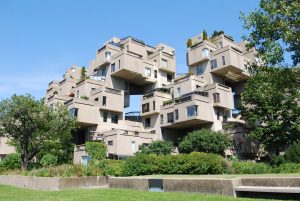 Is every building made out of concrete automatically Brutalist? The answer is yes, according to a recent article on Habitat in the New York Times. But this is a gross over-simplification. Brutalism refers to buildings that dramatize the rough character of concrete. Paul Rudolph’s striated Art and Architecture Building (1963) at Yale is the preeminent example. The roughened concrete is used throughout the building, inside and out. The A & A exhibits another quality of Brutalism—it’s monumental. But not all architects who exposed concrete were striving for this quality. Pier Luigi Nervi, for example, built exclusively in concrete but gave the material a smooth, sculptural quality that is anything but brutal. I. M. Pei’s Society Hill Towers in Philadelphia use a poured-in-place concrete facade that is similarly plastic, smooth surfaces with rounded corners. Many architects went to great lengths to make precast elements that were machinelike and precise, not qualities generally associated with Brutalism. (The glassy concrete of Piano and Ando today is likewise non-Brutalist.) The precast concrete of Philip Johnson during his neo-classical period is almost delicate. Which brings us to Habitat. It is all exposed concrete on the exterior, since the boxes were precast in a factory, although great efforts were made to make the material as smooth and blemish-free as possible. (At one point the option of building the project out of steel was considered.) Safdie used concrete not because he was seeking a rough and monumental aesthetic, but because he wanted to show how prefabrication could be used to make mass housing. There is another litmus test of Brutalism. Buildings like Habitat remain popular with their users. If people don’t hate it, it can’t be Brutalist.
Is every building made out of concrete automatically Brutalist? The answer is yes, according to a recent article on Habitat in the New York Times. But this is a gross over-simplification. Brutalism refers to buildings that dramatize the rough character of concrete. Paul Rudolph’s striated Art and Architecture Building (1963) at Yale is the preeminent example. The roughened concrete is used throughout the building, inside and out. The A & A exhibits another quality of Brutalism—it’s monumental. But not all architects who exposed concrete were striving for this quality. Pier Luigi Nervi, for example, built exclusively in concrete but gave the material a smooth, sculptural quality that is anything but brutal. I. M. Pei’s Society Hill Towers in Philadelphia use a poured-in-place concrete facade that is similarly plastic, smooth surfaces with rounded corners. Many architects went to great lengths to make precast elements that were machinelike and precise, not qualities generally associated with Brutalism. (The glassy concrete of Piano and Ando today is likewise non-Brutalist.) The precast concrete of Philip Johnson during his neo-classical period is almost delicate. Which brings us to Habitat. It is all exposed concrete on the exterior, since the boxes were precast in a factory, although great efforts were made to make the material as smooth and blemish-free as possible. (At one point the option of building the project out of steel was considered.) Safdie used concrete not because he was seeking a rough and monumental aesthetic, but because he wanted to show how prefabrication could be used to make mass housing. There is another litmus test of Brutalism. Buildings like Habitat remain popular with their users. If people don’t hate it, it can’t be Brutalist.
On Culture and Architecture

This superb essay has mercifully dented some of my ignorance concerning Brutalism. Thank you.